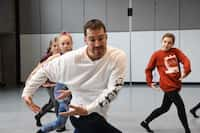There are plenty of places in Dallas to get insight into the world of presidential politics and learn about the past.

George W. Bush Presidential Center
The center's 14,000-square-foot museum displays Bush memorabilia from before, during and after his presidency; attire worn by first lady Laura Bush to state balls and such; 9/11 artifacts; and a replica of the Oval Office, where you can get your picture taken sitting at a copy of the 19th-century Resolute Desk.
The current "Path to the Presidency" exhibit, on view through Oct. 9, lets you step into a candidate's shoes for an interactive peek at past presidential campaigns, the changing face of the American electorate and life on the campaign trail. Practice your candidate handshake on a "Grip-o-Meter," pose for a campaign poster, check out famous campaign buttons dating back to the 1800s and more.
2943 SMU Blvd., Dallas. Find details in our listing.

The Sixth Floor Museum
The venue's permanent exhibit - a mix of photography, video, audio and other types of media - on the life, death and legacy of President John F. Kennedy occupies the sixth floor of the circa-1901 former Texas School Book Depository. It includes the "sniper's perch" from which Lee Harvey Oswald shot and killed the president on Dallas' most infamous day, Nov. 22, 1963.
On view through Nov. 13, "A Time for Greatness: The 1960 Kennedy Campaign" recalls one of the closest elections in U.S. history, which pitted the energy and optimism of John F. Kennedy against the experience and reputation of Richard Nixon. The exhibit, which showcases campaign memorabilia, photographs and film from the museum's collection, is a colorful look at the Kennedy campaign, which offers a timely exploration of presidential politics from a different era, connecting one historic election year to another.
411 Elm St., Dallas. Find details in our listing.

The Dallas Museum of Art
There are a couple interesting things to see here.
Gothic revial bed: Chalk this one up as a reminder to not count your presidential chickens before they're hatched. Supporters of presidential candidate Henry Clay commissioned an elaborately carved bed, intended for the White House, in 1844.
But then, whoops, Clay lost the presidential election to James Polk and the bed ended up at Rosedown plantation in Louisiana until it was sold to the Dallas Museum of Art.

George Washington portrait: Rembrandt Peale was just 17 when he painted George Washington, who posed for him in 1795. Peale said, "I was up before daylight and putting everything in the best condition for the sitting with which I was to be honored, but before the hour arrived became so agitated that I could scarcely mix my colors." You can see how the painting turned out at the DMA on the fourth floor.
1717 N Harwood St, Dallas. Find details in our listing.
Information for this story was drawn from The Dallas Morning News archives, with additional contributions from Ann Pinson and Sara Frederick Burgos.






